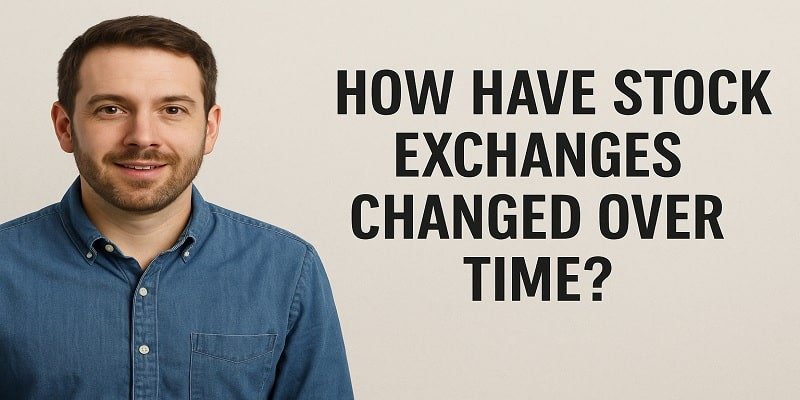“How Have Stock Exchanges Changed Over Time?”
How Have Stock Exchanges Changed Over Time? If you have ever watched the news on Wall Street or have taken an interest in investing, you must have heard about stock exchanges. But do you know that today, stock exchanges do not work exactly the same way as they did when they started? Absolutely! As technology, globalization, and investor needs have evolved, stock exchanges have also changed.
In this article, we will take a closer look at “how stock exchanges have changed over time” in 10 easy-to-understand points. Whether you are a new investor or a fan of finance history, this guide is for you.
1. From Coffee Shops to Digital Screens
Earlier stock exchanges were not at all like today.
In the 1600s, the Amsterdam Stock Exchange was a place where merchants traded company shares. In the U.S., the NYSE began in 1792 under a buttonwood tree, when 24 stockbrokers signed the famous Buttonwood Agreement.
In those days, deals were done face-to-face. Traders would meet in coffee shops, write paper slips, and shout out orders. Today, almost everything happens on digital platforms.
Fun fact: NASDAQ was the world’s first electronic stock exchange, launched in 1971!
2. Rise of Electronic Trading
The biggest change? Electronic trading.
Before the 1990s, most orders were manual — over the phone or in person. Slow and prone to mistakes.
Today, through platforms like E*TRADE, Robinhood, and TD Ameritrade, you can buy or sell stocks from your phone in seconds. This shift has made stock exchanges efficient and accessible.
The way stock exchanges operate today clearly reflects this digital revolution.
3. Wider Access for Everyone
Historically, stock trading was limited to wealthy people or broker clients. Common Americans were left out.
But around 2019, commission-free trades, discount brokers, and apps have brought millions of ordinary people into the market. Whether you have $100 or $100,000, you can invest.
This democratization is a powerful example of how stock exchanges have changed over time.
🔗 Robinhood and the rise of retail investors
4. Real-Time Data and Market Transparency
Earlier, stock information was slow and costly — from newspapers, TV tickers, or broker phone calls.
Today? With one tap, you can see real-time stock prices, earnings, market trends, and analyst ratings. Platforms like Yahoo Finance, Bloomberg instantly provide detailed insights.
This shift towards transparency has built investor trust and helped people make smarter decisions — a major change in the stock exchange ecosystem.
5. More Than Just Stocks: New Asset Classes
Originally, stock exchanges were only for stocks. Today’s exchanges have offered more:
• ETFs (Exchange Traded Funds)
• Options
• Cryptocurrencies
• REITs (Real Estate Investment Trusts)
• SPACs (Special Purpose Acquisition Companies)
With more investment products, the market serves diverse strategies, goals, and risk levels.
This expansion shows how stock exchanges have changed over time to meet modern investor demands.
6. High Frequency Trading (HFT)
A futuristically big change is High Frequency Trading — where algorithms execute thousands of trades in milliseconds.
Firms such as Citadel and Renaissance Technologies use powerful computers to earn tiny profits across millions of trades. Controversial, but the speed and volume of modern markets have significantly reshaped.
This increases liquidity but also raises questions about fairness and volatility.
🔗 What is high-frequency trading?
7. Greater Government Regulation
As stock markets grew, so did the need for investor protection. Major events like the Great Depression of 1929, and the financial crisis of 2008 forced the introduction of stronger regulation.
Key reforms include:
• SEC (Securities and Exchange Commission) was established in 1934
• Dodd-Frank Act (2010) tightened regulations post-2008 crash
• Regulation Fair Disclosure (2000) encouraged equal information sharing
All these reforms show how stock exchanges have changed over time for the better, with more accountability and fewer shady deals.
8. Globalization of Stock Markets
First money U.S. I was in the companies. Today, NYSE and NASDAQ are global giants from China, Europe, India, etc. Who has been listed? U.S. Investors can easily invest in foreign stocks through ADRs (American Depositary Receipts) or global ETFs.
This global reach shows how interconnected markets have become — another example of how stock exchanges have changed over time.
9. Social Media and Meme Stocks
The most recent and unusual change is meme stocks — like GameStop and AMC — driven by platforms like Reddit’s r/WallStreetBets.
For the first time, social media has had a massive impact on trading volumes and stock prices. Millions of retail investors challenged hedge funds.
This phenomenon clearly shows how stock exchanges operate now also take shape from online communities.
10. Shift Toward ESG and Ethical Investing
Modern investors now look for purpose, not just profit. ESG investing — Environmental, Social, Governance — has become a major trend. Stock exchanges now offer ESG-focused indices and demand ethical reporting from companies.
This shift shows how stock exchanges have changed over time, where ethics and transparency have become as important as returns.
🔗 Learn more about ESG investing
Summary Table: 10 Ways Stock Exchanges Have Changed
| # | Change Over Time | Description |
|---|---|---|
| 1 | Coffee shops → Digital platforms | Physical se fully electronic exchanges tak ka transition |
| 2 | Manual → Electronic trading | Faster, cheaper, more accessible orders |
| 3 | Rich-only → Everyone can invest | Democratic investing, sab ke liye accessible |
| 4 | Delayed info → Real-time transparency | Instant access to prices and data |
| 5 | Just stocks → New asset types | ETFs, crypto, REITs, SPACs, options etc. |
| 6 | Slow trades → High-frequency trading | Ultra-fast algorithms execute enormous volume |
| 7 | Minimal rules → Strong regulation | SEC and reforms protect investors |
| 8 | Local companies → Global listings | International companies listed on U.S. exchanges |
| 9 | News-driven → Social media-driven | Meme stocks and retail momentum from online forums |
| 10 | Profit-only → Purpose-driven | ESG and ethical standards shaping investing |
Why This Matters for You
Understanding how stock exchanges have changed over time helps you become smarter with investing. These changes have made investing fast, easy, safer, and inclusive. Today you can:
• Invest from your phone
• Learn with free global tools
• Diversify
• Invest according to your values
All of this is possible because stock exchanges have evolved so much.
Final Thoughts: How Have Stock Exchanges Changed Over Time?
From a tree on Wall Street to your smartphone — stock exchanges have come a long way. The evolution of technology, regulation, and investor expectations has reshaped the market.
The next time you place a trade or read about the NYSE — remember: You’re part of a system that has evolved for centuries.
Want more information?
FAQs: How Have Stock Exchanges Changed Over Time?
1. How were stock exchanges in the past?
In the past, trades happened face-to-face, with paper slips, and hand signals — no apps or digital screens!
2. What’s the biggest change in stock exchanges today?
Digital trading. Today, most trades are instant through apps like Robinhood and E*TRADE.
3. Can regular people trade stocks now?
Yes! Because of commission-free apps and low barriers, anyone can start investing — even with $10.
4. What are “meme stocks”?
Meme stocks are those that go viral on social media, and the price takes a roller coaster ride due to the hype.
5. Why is ESG investing important now?
ESG investing focuses on companies that care about environment, social issues and ethics — which is a very important trend for modern investors.
More Like This-


